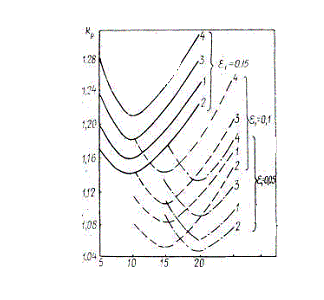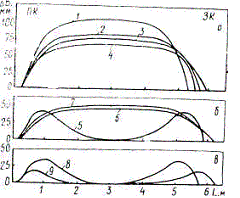 where V0 - Volume of an initial sample;
Vl - Volume of a sheet with the wide side entered in walk around of a peal.
where V0 - Volume of an initial sample;
Vl - Volume of a sheet with the wide side entered in walk around of a peal.

It is known, that different width a peal depends on extracts at broach and to breakdown of width, their attitude, divisibility of deformation, a corner of a problem of a peal in are shaky. As additional factors at modelling have accepted relative reduction in one pass at breakdown of width and number of passes at a problem of a peal on one diagonal before its change. Research have executed a classical method - by a variation of one parameter - factor and maintenance of the others at the fixed levels. Reduction at broach in all experiences have accepted to the constants equal of 10 %. A corner of capture 0 changed in a range 5-20o with step 5o, number of adjacent reversive passes to one diagonal Nsm - a range 1 - 5, relative reduction in each adjacent pass å - in a range 0,05-0,15 with step 0,05. For reception of the symmetric form of a final peal provided equality of extracts at a proskating rink with a problem on a diagonal. In all experiences maintained value of factor of an extract at breakdown of the width, equal 3. Exception became a case with four passes with relative reductions on 0,15 at a problem on each diagonal when the factor is equal more than 4. Results of research are shown on fig. 1. From figure it is visible, that to each value å, the family of curves belongs

Which minima - correspond to approximately identical values 0. In each family of curves the minimal values Kr - decrease at reduction Nñì however the least value Kr has at Nsm = 2. From figure it is visible also, that the least value Kr in all area of research corresponds to the following values of parameters proskating rinks: e = 0,05, Nsm = 2, 0 = 20 o . In real conditions thicksheets millvalues of these parameters can not provide required a temperature mode and productivity because of the big number of passes. Therefore optimum ranges of change of parameters it is necessary to accept: e =0,08 - 0,14, Nsm - 2, 0 = 15 - 20 o . The optimum corner of a problem can be defined under the formula

where esm — Relative reduction for two adjacent pass. The technology developed in laboratory conditionsProskating rinks of thick sheets from slabs have fulfilled on fourcelinder cage mill 2000 Volgograd a metal works. Have executed trial proskating rinks of slabs from lowcarbon steels in the sizes 180x550x1400 mm on sheets in width 1200 - 1500 mm under various circuits and modes reduction. Width of ready sheet peals measured after their cooling manually through 250 mm on length. Longitudinal structures different width skilled sheet peals are shown on fig. 2

Apparently from fig. 2, at the longitudinal circuit proskating rinks the developed modes of breakdown of width (modes 3 and 4) provide reduction longitudinal different width sheets on 20-30 mm (24-31 %) in comparison with different width sheets, rolling on traditional modes 1 and 2. At the cross-section circuit proskating rinks different width sheets, rolling on a new mode 9, decreases for 11 mm (37 %) and length of the convex ends of a peal - on 100-150 mm.
Calculations show, that application of the developed technology proskating rinks of thick sheets from slabs in weight 0,8-1,5 t at the attitude of width of ready strips and the slabs, equal to two and more, the economy of metal due to reduction lateral and face cut and will make 10-20 kg / t. The technology can be introduced on working thick - sheet mills without radical reconstruction.
The technology proskating rinks of the thick sheets, based on application in cross-section draft passes of a problem of a peal « on a corner » and changes of a diagonal after two adjacent reversive passes is developed and tested on industrial mill new steel zymosis. Optimum parameters proskating rinks are determined: a corner of a problem 15-20 °, total relative reduction for two adjacent reversive passes on one diagonal - 0,2-0,25. The technology provides reduction longitudinal different width sheets on 20-30 mm, length of convex end faces on 100-150 mm. The economy of metal at a proskating rink of thick sheets from slabs in weight 0,8-1,5 t makes 10-20 kg / t.
CONCLUSIONS:
The main page